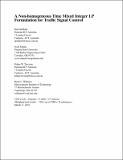| dc.contributor.author | Guilliard, Iain | |
| dc.contributor.author | Sanner, Scott | |
| dc.contributor.author | Trevizan, Felipe W. | |
| dc.contributor.author | Williams, Brian C | |
| dc.date.accessioned | 2018-06-14T13:32:58Z | |
| dc.date.available | 2018-06-14T13:32:58Z | |
| dc.date.issued | 2016 | |
| dc.identifier.issn | 0361-1981 | |
| dc.identifier.uri | http://hdl.handle.net/1721.1/116302 | |
| dc.description.abstract | Urban traffc congestion is on the increase worldwide; therefore, it is critical to maximize the capacity and throughput of the existing road infrastructure with optimized traffc signal control. For that purpose, this paper builds on the body of work in mixed integer linear programming (MILP) approaches that attempt to optimize traffc signal control jointly over an entire traffc network and specifcally on improving the scalability of these methods for large numbers of intersections. The primary insight in this work stems from the fact that MILP-based approaches to traffc control used in a receding horizon control manner (that replan at fxed time intervals) need to compute high-fdelity control policies only for the early stages of the signal plan. Therefore, coarser time steps can be used to see over a long horizon to adapt preemptively to distant platoons and other predicted long-term changes in traffc?ows. To that end, this paper contributes the queue transmission model (QTM), which blends elements of cell-based and link-based modeling approaches to enable a nonhomogeneous time MILP formulation of traffc signal control. Experimentation is then carried out with this novel QTM-based MILP control in a range of traffc networks, and it is demonstrated that the nonhomogeneous MILP formulation achieves (a) substantially lower delay solutions, (b) improved per vehicle delay distributions, and (c) more optimal travel times over a longer horizon in comparison with the homogeneous MILP formulation with the same number of binary and continuous variables. | en_US |
| dc.description.sponsorship | NICTA | en_US |
| dc.description.sponsorship | NSW Trade & Investment | en_US |
| dc.publisher | Transportation Research Board | en_US |
| dc.relation.isversionof | http://dx.doi.org/10.3141/2595-14 | en_US |
| dc.rights | Creative Commons Attribution-Noncommercial-Share Alike | en_US |
| dc.rights.uri | http://creativecommons.org/licenses/by-nc-sa/4.0/ | en_US |
| dc.source | Other univ. web domain | en_US |
| dc.title | Nonhomogeneous Time Mixed Integer Linear Programming Formulation for Traffic Signal Control | en_US |
| dc.type | Article | en_US |
| dc.identifier.citation | Guilliard, Iain, et al. “Nonhomogeneous Time Mixed Integer Linear Programming Formulation for Traffic Signal Control.” Transportation Research Record: Journal of the Transportation Research Board, vol. 2595, Jan. 2016, pp. 128–38. | en_US |
| dc.contributor.department | Massachusetts Institute of Technology. Department of Aeronautics and Astronautics | en_US |
| dc.contributor.mitauthor | Williams, Brian C | |
| dc.relation.journal | Transportation Research Record: Journal of the Transportation Research Board | en_US |
| dc.eprint.version | Original manuscript | en_US |
| dc.type.uri | http://purl.org/eprint/type/JournalArticle | en_US |
| eprint.status | http://purl.org/eprint/status/NonPeerReviewed | en_US |
| dc.date.updated | 2018-04-18T12:15:21Z | |
| dspace.orderedauthors | Guilliard, Iain; Sanner, Scott; Trevizan, Felipe W.; Williams, Brian C. | en_US |
| dspace.embargo.terms | N | en_US |
| dc.identifier.orcid | https://orcid.org/0000-0002-1057-3940 | |
| mit.license | OPEN_ACCESS_POLICY | en_US |
